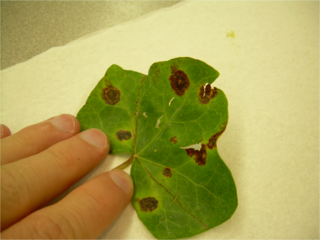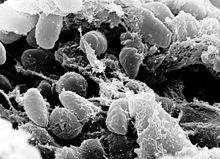
Enterobacteriaceae is a large family of Gram-negative bacteria. It was first proposed by Rahn in 1936, and now includes over 30 genera and more than 100 species. Its classification above the level of family is still a subject of debate, but one classification places it in the order Enterobacterales of the class Gammaproteobacteria in the phylum Pseudomonadota. In 2016, the description and members of this family were emended based on comparative genomic analyses by Adeolu et al.

Enterobacterales is an order of Gram-negative, non-spore forming, facultatively anaerobic, rod-shaped bacteria with the class Gammaproteobacteria. The type genus of this order is Enterobacter.

The Pasteurellaceae comprise a large family of Gram-negative bacteria. Most members live as commensals on mucosal surfaces of birds and mammals, especially in the upper respiratory tract. Pasteurellaceae are typically rod-shaped, and are a notable group of facultative anaerobes. Their biochemical characteristics can be distinguished from the related Enterobacteriaceae by the presence of oxidase, and from most other similar bacteria by the absence of flagella.

The Xanthomonadales are a bacterial order within the Gammaproteobacteria. They are one of the largest groups of bacterial phytopathogens, harbouring species such as Xanthomonas citri, Xanthomonas euvesicatoria, Xanthomonas oryzae and Xylella fastidiosa. These bacteria affect agriculturally important plants including tomatoes, bananas, citrus plants, rice, and coffee. Many species within the order are also human pathogens. Species within the genus Stenotrophomonas are multidrug resistant opportunistic pathogens that are responsible for nosocomial infections in immunodeficient patients.
The Caryophanaceae is a family of Gram-positive bacteria. In 2020, the now defunct family Planococcaceae was merged into Caryophanaceae to rectify a nomenclature anomaly. The type genus of this family is Caryophanon.
Conserved signature inserts and deletions (CSIs) in protein sequences provide an important category of molecular markers for understanding phylogenetic relationships. CSIs, brought about by rare genetic changes, provide useful phylogenetic markers that are generally of defined size and they are flanked on both sides by conserved regions to ensure their reliability. While indels can be arbitrary inserts or deletions, CSIs are defined as only those protein indels that are present within conserved regions of the protein.
Ureibacillus is a genus of gram-negative bacteria within the largely gram-positive Bacillota. Ureibacilli are motile and form spherical endospores. The type species of the genus is Ureibacillus thermosphaericus.
The Coriobacteriia are a class of Gram-positive bacteria within the Actinomycetota phylum. Species within this group are nonsporulating, strict or facultative anaerobes that are capable of thriving in a diverse set of ecological niches. Gordonibacter species are the only members capable of motility by means of flagella within the class. Several species within the Coriobacteriia class have been implicated with human diseases that range in severity. Atopobium, Olsenella, and Cryptobacterium species have responsible for human oral infections including periodontitis, halitosis, and other endodontic infections. Eggerthella species have been associated with severe blood bacteraemia and ulcerative colitis.
The Erwiniaceae are a family of Gram-negative bacteria which includes a number of plant pathogens and insect endosymbionts. This family is a member of the order Enterobacterales in the class Gammaproteobacteria of the phylum Pseudomonadota. The type genus of this family is Erwinia.
The Pectobacteriaceae are a family of Gram-negative bacteria which largely consist of plant pathogens. This family is a member of the order Enterobacterales in the class Gammaproteobacteria of the phylum Pseudomonadota. The type species of this family is Pectobacterium.
The Hafniaceae are a family of Gram-negative bacteria. This family is a member of the order Enterobacterales in the class Gammaproteobacteria of the phylum Pseudomonadota. Genera in this family include the type genus Hafnia, along with Edwardsiella and Obesumbacterium.

The Morganellaceae are a family of Gram-negative bacteria that include some important human pathogens formerly classified as Enterobacteriaceae. This family is a member of the order Enterobacterales in the class Gammaproteobacteria of the phylum Pseudomonadota. Genera in this family include the type genus Morganella, along with Arsenophonus, Cosenzaea, Moellerella, Photorhabdus, Proteus, Providencia and Xenorhabdus.
The Budviciaceae are a family of Gram-negative bacteria. This family is a member of the order Enterobacterales in the class Gammaproteobacteria of the phylum Pseudomonadota. The type genus of this family is Budvicia.
Neobacillus is a genus of rod-shaped bacteria that show Gram-positive or Gram-variable staining. This genus belongs under the family Bacillaceae within the order Bacillales. The type species of Neobacillus is Neobacillus niacini.
Cytobacillus is a genus of rod-shaped bacteria that stain either Gram-positive or Gram-variable in the family Bacillaceae within the order Bacillales. The type species for this genus is Cytobacillus firmus.
Metalysinibacillus is a genus of Gram-Positive rod-shaped bacteria in the family Caryophanaceae from the order Caryophanales. The type species of this genus is Metalysinibacillus jejuensis.
Metaplanococcus is a genus of Gram-Positive or Gram-variable, cocci or short rod-shaped bacteria in the family Caryophanaceae from the order Caryophanales. The type species of this genus is Metaplanococcus flavidus.
The Eggerthellaceae are a family of Gram-positive, rod- or coccus-shaped Actinomycetota. It is the sole family within the order Eggerthellales.
Natrialbales is an order of halophilic, chemoorganotrophic archaea within the class Haloarchaea. The type genus of this order is Natrialba.
Haloferacales is an order of halophilic, chemoorganotrophic or heterotrophic archaea within the class Haloarchaea. The type genus of this order is Haloferax.




